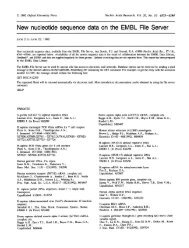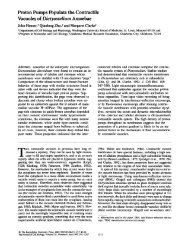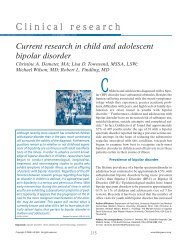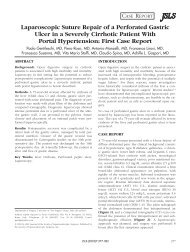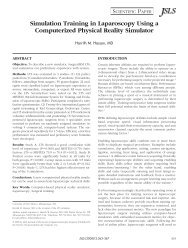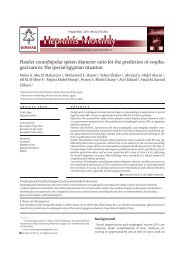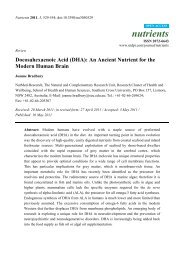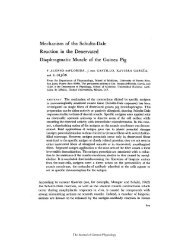Download PDF - BioMedSearch
Download PDF - BioMedSearch
Download PDF - BioMedSearch
You also want an ePaper? Increase the reach of your titles
YUMPU automatically turns print PDFs into web optimized ePapers that Google loves.
Table S2 Predicted membrane proteins in the L.<br />
pneumophila Dot/Icm effector repertoire. Two hundred<br />
and seventy-five proteins encoded in the genome of L. pneumophila<br />
strain Philadelphia were identified as effector proteins in a recent<br />
high-throughput study [13]. Here the protein sequences of these<br />
effectors as well effectors unique to L. pneumophila strain 130b were<br />
analyzed with HMMtop [68] and TMHMM v 2.0 [69] to predict<br />
transmembrane segments. The two predictors have independent<br />
means of assessing hydrophobicity and other characteristics of<br />
alpha-helical transmembrane segments, yet concordant predictions<br />
are seen for most proteins.<br />
(DOC)<br />
References<br />
1. Horwitz MA (1983) The Legionnaires’ disease bacterium (Legionella pneumophila)<br />
inhibits phagosome-lysosome fusion in human monocytes. J Exp Med 158:<br />
2108–2126.<br />
2. Horwitz MA, Silverstein SC (1980) Legionnaires’ disease bacterium (Legionella<br />
pneumophila) multiples intracellularly in human monocytes. J Clin Invest 66:<br />
441–450.<br />
3. Kagan JC, Roy CR (2002) Legionella phagosomes intercept vesicular traffic from<br />
endoplasmic reticulum exit sites. Nat Cell Biol 4: 945–954.<br />
4. Horwitz MA (1983) Formation of a novel phagosome by the Legionnaires’<br />
disease bacterium (Legionella pneumophila) in human monocytes. J Exp Med 158:<br />
1319–1331.<br />
5. Tilney LG, Harb OS, Connelly PS, Robinson CG, Roy CR (2001) How the<br />
parasitic bacterium Legionella pneumophila modifies its phagosome and transforms<br />
it into rough ER: implications for conversion of plasma membrane to the ER<br />
membrane. J Cell Sci 114: 4637–4650.<br />
6. Isberg RR, O’Connor TJ, Heidtman M (2009) The Legionella pneumophila replication<br />
vacuole: making a cosy niche inside host cells. Nat Rev Microbiol 7: 13–24.<br />
7. Roy CR, Tilney LG (2002) The road less traveled: transport of Legionella to the<br />
endoplasmic reticulum. J Cell Biol 158: 415–419.<br />
8. Urwyler S, Nyfeler Y, Ragaz C, Lee H, Mueller LN, et al. (2009) Proteome<br />
analysis of Legionella vacuoles purified by magnetic immunoseparation reveals<br />
secretory and endosomal GTPases. Traffic 10: 76–87.<br />
9. Dorer MS, Kirton D, Bader JS, Isberg RR (2006) RNA interference analysis of<br />
Legionella in Drosophila cells: exploitation of early secretory apparatus dynamics.<br />
PLoS Pathog 2: e34.<br />
10. Segal G, Purcell M, Shuman HA (1998) Host cell killing and bacterial<br />
conjugation require overlapping sets of genes within a 22-kb region of the<br />
Legionella pneumophila genome. Proc Natl Acad Sci U S A 95: 1669–1674.<br />
11. Segal G, Shuman HA (1997) Characterization of a new region required for<br />
macrophage killing by Legionella pneumophila. Infect Immun 65: 5057–5066.<br />
12. Vogel JP, Andrews HL, Wong SK, Isberg RR (1998) Conjugative transfer by the<br />
virulence system of Legionella pneumophila. Science 279: 873–876.<br />
13. Zhu W, Banga S, Tan Y, Zheng C, Stephenson R, et al. (2011) Comprehensive<br />
identification of protein substrates of the Dot/Icm type IV transporter of<br />
Legionella pneumophila. PLoS One 6: e17638.<br />
14. Hubber A, Roy CR (2010) Modulation of host cell function by Legionella<br />
pneumophila type IV effectors. Annu Rev Cell Dev Biol 26: 261–283.<br />
15. Franco IS, Shuman HA, Charpentier X (2009) The perplexing functions and<br />
surprising origins of Legionella pneumophila type IV secretion effectors. Cell<br />
Microbiol 11: 1435–1443.<br />
16. Newton HJ, Ang DK, van Driel IR, Hartland EL (2010) Molecular pathogenesis<br />
of infections caused by Legionella pneumophila. Clin Microbiol Rev 23: 274–298.<br />
17. Weber SS, Ragaz C, Hilbi H (2009) Pathogen trafficking pathways and host<br />
phosphoinositide metabolism. Mol Microbiol 71: 1341–1352.<br />
18. Machner MP, Isberg RR (2007) A bifunctional bacterial protein links GDI<br />
displacement to Rab1 activation. Science 318: 974–977.<br />
19. Shohdy N, Efe JA, Emr SD, Shuman HA (2005) Pathogen effector protein<br />
screening in yeast identifies Legionella factors that interfere with membrane<br />
trafficking. Proc Natl Acad Sci U S A 102: 4866–4871.<br />
20. Ingmundson A, Delprato A, Lambright DG, Roy CR (2007) Legionella<br />
pneumophila proteins that regulate Rab1 membrane cycling. Nature 450:<br />
365–369.<br />
21. Weber SS, Ragaz C, Reus K, Nyfeler Y, Hilbi H (2006) Legionella pneumophila<br />
exploits PI(4)P to anchor secreted effector proteins to the replicative vacuole.<br />
PLoS Pathog 2: e46.<br />
22. Cazalet C, Rusniok C, Bruggemann H, Zidane N, Magnier A, et al. (2004)<br />
Evidence in the Legionella pneumophila genome for exploitation of host cell<br />
functions and high genome plasticity. Nature Genet 36: 1165–1173.<br />
23. Pan X, Luhrmann A, Satoh A, Laskowski-Arce MA, Roy CR (2008) Ankyrin<br />
repeat proteins comprise a diverse family of bacterial type IV effectors. Science<br />
320: 1651–1654.<br />
Acknowledgments<br />
A Mitochondrial Carrier Protein in Legionella<br />
We thank Vladamir Likić, Ana Traven and Chaille Webb for expert<br />
advice, and Victoria Hewitt and members of the Lithgow and Hartland<br />
labs for critical comments on the manuscript. We are grateful to Patrice<br />
Riedmaier for immunoblot analysis of 4HA-LncP, and to Craig Roy for<br />
the gift of pEC34 (pCya). The authors acknowledge the facilities, scientific<br />
and technical assistance of Monash Micro Imaging, Monash University,<br />
Victoria, Australia.<br />
Author Contributions<br />
Conceived and designed the experiments: PD MA JT JHJ CMM EB FP<br />
KG GG ELH TL. Performed the experiments: PD MA SFL RS JT JHJ<br />
CMM EB GG. Analyzed the data: PD SB TN JT JHJ CMM EB FP KG<br />
GG ELH TL. Contributed reagents/materials/analysis tools: AM GF.<br />
Wrote the paper: PD ELH TL FP.<br />
24. Price CT, Al-Quadan T, Santic M, Jones SC, Abu Kwaik Y (2010) Exploitation<br />
of conserved eukaryotic host cell farnesylation machinery by an F-box effector of<br />
Legionella pneumophila. J Exp Med 207: 1713–1726.<br />
25. Lomma M, Dervins-Ravault D, Rolando M, Nora T, Newton HJ, et al. (2010)<br />
The Legionella pneumophila F-box protein Lpp2082 (AnkB) modulates ubiquitination<br />
of the host protein parvin B and promotes intracellular replication. Cell<br />
Microbiol 12: 1272–1291.<br />
26. Kubori T, Hyakutake A, Nagai H (2008) Legionella translocates an E3 ubiquitin<br />
ligase that has multiple U-boxes with distinct functions. Mol Microbiol 67:<br />
1307–1319.<br />
27. Degtyar E, Zusman T, Ehrlich M, Segal G (2009) A Legionella effector acquired<br />
from protozoa is involved in sphingolipids metabolism and is targeted to the host<br />
cell mitochondria. Cell Microbiol 11: 1219–1235.<br />
28. Alcock F, Clements A, Webb C, Lithgow T (2010) Evolution. Tinkering inside<br />
the organelle. Science 327: 649–650.<br />
29. Jarmuszkiewicz W, Czarna M, Swida A, Behrendt M (2004) Uncoupling<br />
Proteins in Amoeboid Eukaryotes, Acanthamoeba castellanii, and Dictyostelium<br />
discoideum. Toxicol Mech Methods 14: 3–6.<br />
30. Chan KW, Slotboom DJ, Cox S, Embley TM, Fabre O, et al. (2005) A novel<br />
ADP/ATP transporter in the mitosome of the microaerophilic human parasite<br />
Entamoeba histolytica. Curr Biol 15: 737–742.<br />
31. Satre M, Mattei S, Aubry L, Gaudet P, Pelosi L, et al. (2007) Mitochondrial<br />
carrier family: repertoire and peculiarities of the cellular slime mould Dictyostelium<br />
discoideum. Biochimie 89: 1058–1069.<br />
32. Dolezal P, Dagley MJ, Kono M, Wolynec P, Likic VA, et al. (2010) The<br />
essentials of protein import in the degenerate mitochondrion of Entamoeba<br />
histolytica. PLoS Pathog 6: e1000812.<br />
33. Young JC, Hoogenraad NJ, Hartl FU (2003) Molecular chaperones Hsp90 and<br />
Hsp70 deliver preproteins to the mitochondrial import receptor Tom70. Cell<br />
112: 41–50.<br />
34. Koehler CM (2004) New developments in mitochondrial assembly. Annu Rev<br />
Cell Dev Biol 20: 309–335.<br />
35. Gabriel K, Pfanner N (2007) The mitochondrial machinery for import of<br />
precursor proteins. Methods Mol Biol 390: 99–117.<br />
36. Neupert W, Herrmann JM (2007) Translocation of proteins into mitochondria.<br />
Annu Rev Biochem 76: 723–749.<br />
37. Chacinska A, Koehler CM, Milenkovic D, Lithgow T, Pfanner N (2009)<br />
Importing mitochondrial proteins: machineries and mechanisms. Cell 138:<br />
628–644.<br />
38. Picault N, Hodges M, Palmieri L, Palmieri F (2004) The growing family of<br />
mitochondrial carriers in Arabidopsis. Trends Plant Sci 9: 138–146.<br />
39. Palmieri F, Pierri CL (2010) Mitochondrial metabolite transport. Essays<br />
Biochem 47: 37–52.<br />
40. Palmieri F (2004) The mitochondrial transporter family (SLC25): physiological<br />
and pathological implications. Pflugers Arch 447: 689–709.<br />
41. Palmieri F, Pierri CL, De Grassi A, Nunes-Nesi A, Fernie AR (2011) Evolution,<br />
structure and function of mitochondrial carriers: a review with new insights.<br />
Plant J 66: 161–181.<br />
42. Palmieri F, Pierri CL (2010) Structure and function of mitochondrial carriers -<br />
role of the transmembrane helix P and G residues in the gating and transport<br />
mechanism. FEBS Lett 584: 1931–1939.<br />
43. Rikihisa Y (2003) Mechanisms to create a safe haven by members of the family<br />
Anaplasmataceae. Ann N Y Acad Sci 990: 548–555.<br />
44. Walker DH (2009) Sennetsu neorickettsiosis: a potentially prevalent, treatable,<br />
acutely incapacitating tropical infectious disease. Am J Trop Med Hyg 81:<br />
187–188.<br />
45. Schroeder GN, Petty NK, Mousnier A, Harding CR, Vogrin AJ, et al. (2010)<br />
Legionella pneumophila strain 130b possesses a unique combination of type IV<br />
secretion systems and novel Dot/Icm secretion system effector proteins.<br />
J Bacteriol 192: 6001–6016.<br />
PLoS Pathogens | www.plospathogens.org 12 January 2012 | Volume 8 | Issue 1 | e1002459



